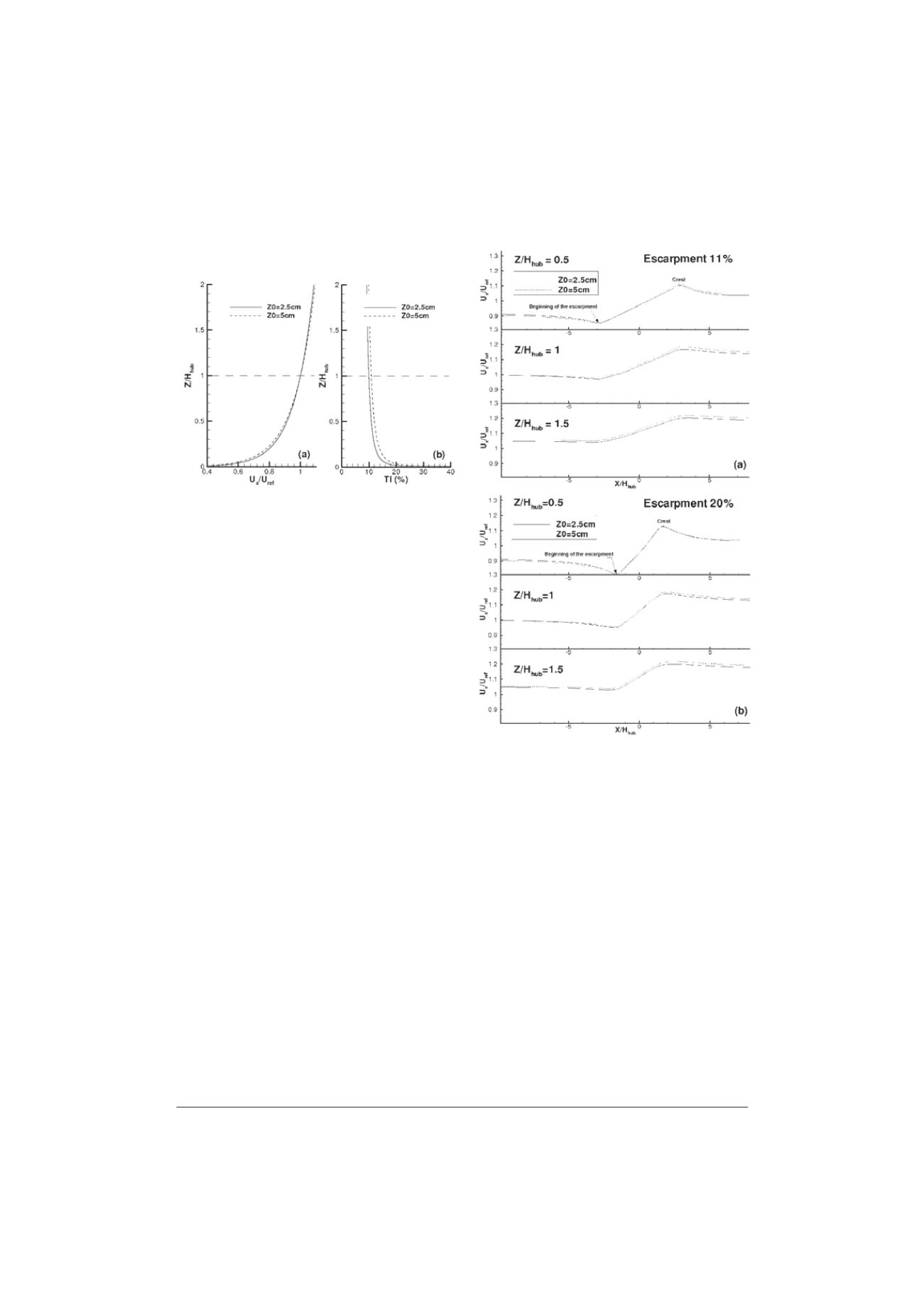
2011 International Conference on Alternative Energy in Developing Countries and Emerging Economies
- 320 -
13b) tended to increase with roughness; the greatest
difference was observed near the ground.
Fig. 13. Effects of roughness at the inlet domain on (a) axial velocity
and (b) turbulence intensity.
Terrain with no turbine
Fig. 14 shows the effects of roughness on the axial
velocity for two escarpments as well as for three heights
above ground. Upstream of the escarpment, where the
terrain was flat, the velocity profile followed the profile
imposed at the inlet.
Onward, and downstream from the escarpment, speed
increased overall with the roughness of the ground; this is
explained by the fact that at these positions, flow met the
inlet profile at
H
hub
and upward. This offset was due to
terrain height. This velocity difference due to roughness
did decrease, however, as the escarpment slope increased.
Thus, at the crest and at
H
hub
, the difference between
velocities was 0.16% for the 11% slope and decreased to
0.11% for the 20% slope.
The increase in roughness height implies that there
was an increase in turbulence intensity in the middle of
the escarpment and at height
H
hub
(Fig. 15) of about 1%;
this difference remained essentially independent of the
terrain slope.
The vertical angle of the flow at mid-escarpment
tended to decrease slightly with increasing ground
roughness (Fig. 16). For both escarpments, the decrease
was approximately 0.13 degrees.
Terrain with wind turbine
Fig. 17 shows the roughness effects on axial velocity
profile and vertical flow angle at the nacelle anemometer
position for the non-operating wind turbine. For the 11%
escarpment (Fig. 17a), increasing surface roughness had
the effect of increasing the axial velocity of about 2.1% at
H
anemo
; this difference increased to 2.4% for the 20%
escarpment (Fig. 17b). The effect of roughness on the
axial velocity remained significant even beyond the
height of 2
H
anemo
. The opposite effect occurred with the
vertical flow angle; a decrease of 0.28 degrees was
observed at the anemometer when roughness increased
(11% escarpment). This difference increased slightly to
0.32 degrees for the 20% escarpment.
Fig. 14. Escarpment with no turbine: effects of roughness on speed-up
for various heights and slopes of (a) 11% and (b) 20%.
The operating turbine (Fig. 18) reduced the effect of
roughness on axial velocity. For the 11% escarpment
(Fig. 18a) and at the anemometer's position, the
difference in axial velocity was approximately 0.86%: a
decrease by half with respect to the case of the non-
operating turbine. This decrease was approximately
0.96% for the 20% escarpment (Fig. 18b). The effect of
roughness on the velocity profile was almost insignificant
at a height of approximately 1.2
H
anemo
.
The right curves shown in Figs. 18a and 18b demonstrate
that the decrease of the vertical flow angle with variation
of roughness was independent of escarpment slope and
was essentially the same as for the case of the non-
operating turbine.
The effect of increasing ground roughness on the NTF
(Figs. 19 and 20) resulted in a shift of the curve upwards.
This effect was greater for higher than for lower free
stream wind speed. For the non-operating rotor and an
11% escarpment (Fig. 19a), nacelle wind speed increase
was about 0.13m/s at FSWS=5m/s. This difference grew
to 0.47m/s for FSWS=20m/s. These increases in speed


